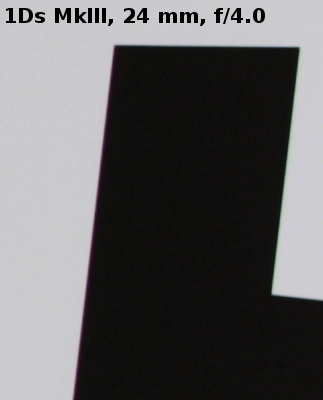Canon EF 24 mm f/1.4L II USM
5. Chromatic aberration

It’s worth noticing that once again we see a quite good accordance between the results, obtained straight from the APS-C sensor of the Canon 50D (green points), and those from the full frame sensor (red points). Both curves are positioned close to each other and have the same shape. Maximum differences between them don’t exceed 0.01% and, taking into account the fact that the measurement errors range from 0.002% to 0.006%, it indicates good level of repetitiveness.
Please Support UsIf you enjoy our reviews and articles, and you want us to continue our work please, support our website by donating through PayPal. The funds are going to be used for paying our editorial team, renting servers, and equipping our testing studio; only that way we will be able to continue providing you interesting content for free. |
- - - - - - - - - - - - - - - - - - - - - - - - - - - - - - - - - - - - - - - - - - - - - - - -
 |
You should remember one thing, though. In this chapter we always talk about lateral chromatic aberration, which is easy to define and to measure. Longitudinal aberration is a different phenomenon. Its effect can be seen very well in the pictures of autofocus testing chart, shown in chapter 10, where objects positioned in some distance (outside the depth of field area) turn green-yellow and those, positioned closer – turn purple-red.
There are several things that need to be emphasized here. Lenses are designed to correct chromatic aberration (both longitudinal and lateral) at the focal plane (so for objects situated in depth of field area) . The faster and more wide-angle the lens, the more difficult this correction might be but a lens’s constructors can be only critically reviewed as far as it goes. Contrary to our initial impression, the Canon 24L corrects both kinds of chromatic aberrations well. The lateral aberration graph, which is presented above, is one proof; the autofocus testing chart pictures in chapter 10 are the other. The picture area on the left, with a fan composed of black and white stripes, is in the frame centre and within the depth of field so, although the f/1.4 aperture was used there, you can see no traces of aberration. On the other hand the aberration is clearly visible outside the depth of field area, but you can hardly nurse any grudge for that. Because of its physical properties, the chromatic aberration can’t be corrected perfectly in the whole range - from the beginning of the lens to infinity.In case of such fast lenses it is an impossible task. There are some exceptions to this rule where the aberration effects are minimized and almost invisible but it concerns such constructions as an Voigtlander APO-Lanthar, which is neither wide angle nor so fast as the L-series lens, tested here.
One more remark at the end...talking about chromatic aberration we shouldn’t mix it up with the purple fringing phenomenon.






